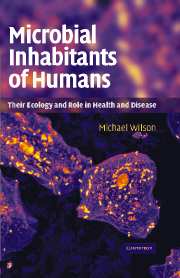Book contents
- Frontmatter
- Contents
- Preface
- Abbreviations used for microbial genera
- 1 An introduction to the human–microbe symbiosis
- 2 The skin and its indigenous microbiota
- 3 The eye and its indigenous microbiota
- 4 The respiratory system and its indigenous microbiota
- 5 The urinary system and its indigenous microbiota
- 6 The reproductive system and its indigenous microbiota
- 7 The gastrointestinal tract and its indigenous microbiota
- 8 The oral cavity and its indigenous microbiota
- 9 Role of the indigenous microbiota in maintaining human health
- 10 Manipulation of the indigenous microbiota
- Index
8 - The oral cavity and its indigenous microbiota
Published online by Cambridge University Press: 06 July 2010
- Frontmatter
- Contents
- Preface
- Abbreviations used for microbial genera
- 1 An introduction to the human–microbe symbiosis
- 2 The skin and its indigenous microbiota
- 3 The eye and its indigenous microbiota
- 4 The respiratory system and its indigenous microbiota
- 5 The urinary system and its indigenous microbiota
- 6 The reproductive system and its indigenous microbiota
- 7 The gastrointestinal tract and its indigenous microbiota
- 8 The oral cavity and its indigenous microbiota
- 9 Role of the indigenous microbiota in maintaining human health
- 10 Manipulation of the indigenous microbiota
- Index
Summary
The oral cavity is not simply the entrance to the gastrointestinal tract (GIT), but consists of a complex system of tissues and organs with a variety of functions which together are involved in selecting food that is suitable for intake and processing the food into a form that is suitable for passage into the rest of the GIT. Another major function of the oral cavity is speech production. With regard to its feeding function, the oral cavity contains several sensory systems which are involved in perceiving the taste, smell, touch, and temperature of the food. This sensory information is analysed in the central nervous system and used to determine the acceptability of the food. If it is regarded as acceptable, then saliva is secreted, chewing is initiated, and eventually swallowing takes place.
Anatomy and physiology of the oral cavity
The oral cavity is formed from the cheeks, the hard and soft palates, and the tongue (Figure 8.1). It contains accessory digestive structures, the teeth, and is connected to the pharynx by an opening known as the fauces. The total surface area of the oral cavity is approximately 200 cm2. The surfaces of the teeth comprise 20% of this, with the remainder being attributable to the oral mucosa. The oral mucosa, like other mucosal surfaces, consists of two layers – an epithelium and an underlying layer of connective tissue, the lamina propria.
- Type
- Chapter
- Information
- Microbial Inhabitants of HumansTheir Ecology and Role in Health and Disease, pp. 318 - 374Publisher: Cambridge University PressPrint publication year: 2004
- 1
- Cited by



